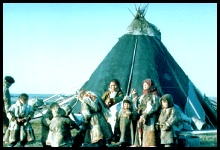
 "C'mon into the chum!" The Nenets (meaning "man") of Siberia are Arctic reindeer herders. They travel great distances up and down the Yamal Peninsula, moving from northern tundra pastures in summer to the more protected sub-Arctic areas in winter. Their portable teepee-like tents are called "chums". The chum is the center of life - a place of storytelling, food preparation, eating and sleeping, and it is the beginning and end of all journeys. Inside the chum the woman is always in charge - on the tundra, it is always the man. Traditionally, clan membership allowed the Nenets to share animals and food, unite and divide herds, and make use of the nearby resources. Like many other indigenous Arctic cultures, their beliefs stressed respect for the land and its resources. In the early 1930s, this region of Arctic Russia underwent dramatic change. The government forced reindeer herders onto newly established collective farms and their children were sent to state-run boarding schools. This eventually led to serious adjustment problems for young people who, after years of government education, remembered little of their parent's way of life and native language.
Click pictures for more information and credits. Library: Arctic, Eurasia, Countries/Places Chukchi, Evenki, Sami, Yup'ik Links: Arctic, Arctic Maps & Weather Reports |

|
DICTIONARY: Just "double-click" any unlinked word on this page for the definition from Merriam-Webster's Student Electronic Dictionary at Word Central. |

|
ARCTIC LIBRARY & GLOSSARY: Check this section for an index of the rest of the things you really need to know about the Arctic. |

|
ARCTIC MAPS & WEATHER REPORTS: Maps of the Northwest Passage, explorers' routes, iceberg sources, Nunavut, the Arctic by treeline, temperature... |

|
ARCTIC LINKS: Even more information! Links to sites related to the Arctic and "Iceberg: the Story of the Throps and the Squallhoots". |

|
GUIDE TO ARCTIC SUNRISE & SUNSET: How much sunlight or darkness is there in the Arctic on each day of the year? |
to is the property of their respective owners, and Athropolis is not responsible for their content.